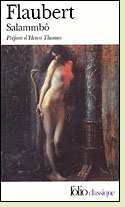Salammbo
by Gustave Flaubert
Reviewed by David Maclaine

Salammbo offers a romantic story of doomed love set between the first two Punic Wars, during a revolt of mercenaries whose riot at a feast spirals into exile, betrayal and civil war. While the rebellious troops struggle for survival in a harsh and hostile land, one of their leaders, an ardent Libyan youth called Matho, falls in love with Salammbo, priestess and daughter of the city's leader, Hamilcar Barca. Matho's daring theft of the sacred veil of the goddess Tanit opens a new phase of conflict, both between the warring forces, and within the soul of Salammbo. Armies maneuver and clash, as Hamilcar Barca attempts to crush the rebellion, and his adversary Hannon maneuvers to make sure that Hamilcar doesn't emerge with too much power. It requires no great insight to guess the story will not end happily.
Readers who know Gustave Flaubert only from Madame Bovary, his meticulous dissection
of a provincial marriage, may be surprised by Salammbo. Instead of the contemporary setting of the earlier
masterpiece, Flaubert offers every exotic extreme he can imagine, painting an
alien age and culture in fierce, vivid colors. There are rich descriptions of
the burning rocks of a harsh wilderness, of ornate temple decorations, and of
high ceremony with crowd scenes and settings that outshine the most lavish
set-pieces of Cecil B. DeMille. The story drips in violence and casual cruelty:
armies are slaughtered wholesale in ambush, children are sacrificed to the
fires of Moloch, captured soldiers are driven to stab their own friends to
death, and every form of execution gets a scene as the story reaches its
climax, in which victims are crucified, trampled by elephants, and, in
the final pages, suffer a long, bloody passage through a murderous mob. Readers
who want to gaze on scenes of vanished splendor, tinged with unbearable horror,
will be happy to follow Flaubert into an incredible lost world. (1862; most editions under 300 pages)
Salammbo appears on the list of The 50 Best Historical Novels for a Survey of Ancient Roman History
Other novels set in ancient Carthage:
Pride of Carthage by David Anthony Durham (2005), about Hannibal and Carthage during the Second Punic War. More info
The Coin of Carthage by Bryher (1963), about ordinary people struggling to survive amid the Second Punic War. More info
Hannibal by Ross Leckie (1996), about the great Carthaginian general and his challenge to Rome. More info
Nonfiction about ancient Carthage:
The Carthaginians by Dexter Hoyos (2010). More info
Carthage Must Be Destroyed: The Rise and Fall of an Ancient Civilization by Richard Miles (2011). More info
The Fall of Carthage by Adrian Keith Goldsworthy (2007). More info
Online:
Carthage at the Ancient History Encyclopedia
Back to Novels of Ancient History
Back to Directory of Book Reviews